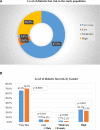Early screening for foot problems in people with diabetes is the need of the hour: 'Save the Feet and Keep Walking Campaign' in India
- PMID: 39097296
- PMCID: PMC11298753
- DOI: 10.1136/bmjdrc-2024-004064
Early screening for foot problems in people with diabetes is the need of the hour: 'Save the Feet and Keep Walking Campaign' in India
Abstract
Introduction: Evidence on the prevalence of foot problems among people with diabetes in India at a national level is lacking. Hence, this study was aimed to assess the burden of high-risk (HR) feet in people with diabetes across India.
Research design and methods: A cross-sectional national-level project 'Save the Feet and Keep Walking' campaign was conducted by the Research Society for the Study of Diabetes in India (RSSDI) from July 10, 2022 to August 10, 2022. A modified version of 3 min foot examination was used to assess the foot problems. Around 10 000 doctors with RSSDI membership were trained online to conduct foot screening and provided a standardised monofilament for detection of loss of protective sensation. People with diabetes aged >18 years who visited the clinics during the study period were examined for foot problems. Data were collected online using the semi-structured questionnaire. A total of 33 259 participants with complete information were included for the final analysis. The foot at risk was categorised based on International Working Group on the Diabetic Foot guidelines 2023.
Results: Nearly 75% of the participants were aged above 45 years. Around 49% had diabetes duration >5 years and uncontrolled diabetes (hemoglobin A1c >8%). Presence of history of foot ulcer (20%), lower limb amputation (15.3%), foot deformities (24.5%) and absence of diminished dorsal pedis and posterior tibial pulses (26.4%) was noted in the study participants. Around 25.2% of them had HR feet and highly prevalent among males. Diabetic kidney and retinal complications were present in 70% and 75.5% of people with HR feet. Presence of heel fissures (OR (95% CI) 4.6 (4.2 to 5.1)) and callus or corns (OR (95% CI) 3.6 (3.3 to 4.0)) were significantly associated with HR feet.
Conclusions: One-fourth of people with diabetes were found to have HR feet in India. The findings are suggestive of regular screening of people with diabetes for foot problems and strengthening of primary healthcare.
Keywords: India; diabetic foot; foot deformities; risk assessment.
© Author(s) (or their employer(s)) 2024. Re-use permitted under CC BY-NC. No commercial re-use. See rights and permissions. Published by BMJ.
Conflict of interest statement
Competing interests: None declared.
Figures
Similar articles
-
Risk assessment for foot ulcers among Tunisian subjects with diabetes: a cross sectional outpatient study.BMC Endocr Disord. 2020 Aug 24;20(1):128. doi: 10.1186/s12902-020-00608-2. BMC Endocr Disord. 2020. PMID: 32831070 Free PMC article.
-
Prevalence of Foot Complications in People With Type 2 Diabetes Mellitus: A Community-Based Survey in Rural Udupi.Int J Low Extrem Wounds. 2018 Sep;17(3):169-175. doi: 10.1177/1534734618791853. Epub 2018 Aug 16. Int J Low Extrem Wounds. 2018. PMID: 30111220
-
Screening diabetic patients at risk for foot ulceration. A multi-centre hospital-based study in France.Diabetes Metab. 2003 Jun;29(3):261-8. doi: 10.1016/s1262-3636(07)70035-6. Diabetes Metab. 2003. PMID: 12909814
-
Implementation of evidence-based foot screening in people with diabetes: A scoping review.J Diabetes Complications. 2025 Mar;39(3):108972. doi: 10.1016/j.jdiacomp.2025.108972. Epub 2025 Feb 12. J Diabetes Complications. 2025. PMID: 39954451
-
Prognostic models for predicting the risk of foot ulcer or amputation in people with type 2 diabetes: a systematic review and external validation study.Diabetologia. 2021 Jul;64(7):1550-1562. doi: 10.1007/s00125-021-05448-w. Epub 2021 Apr 27. Diabetologia. 2021. PMID: 33904946 Free PMC article.
References
-
- International Diabetes Federation . IDF Diabetes Atlas. 10th edn. Brussels, Belgium: 2021. https://www.diabetesatlas.org Available.
-
- Harrison-Blount M, Hashmi F, Nester C, et al. The prevalence of foot problems in an Indian population. Diabetic Foot J. 2017;20:95–102.
MeSH terms
LinkOut - more resources
Full Text Sources
Medical

